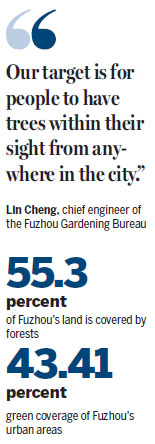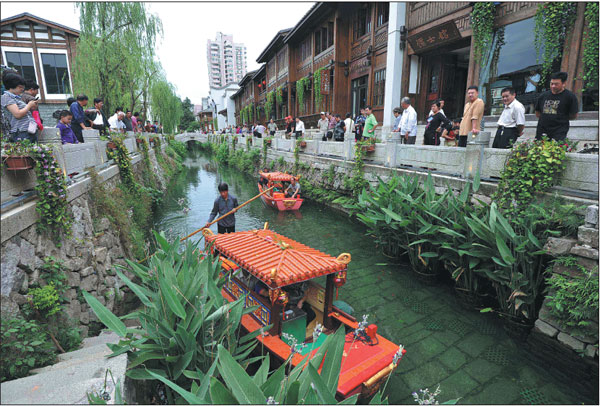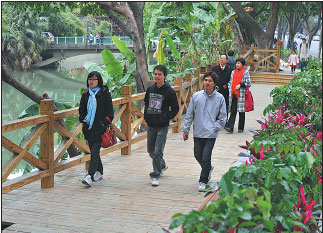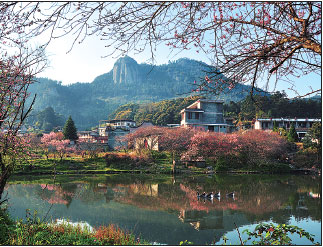Rare species return to Fujian capital
Wetland's biodiversity and urban planting show progress of efforts to improve environment
Chinese crested tern, once thought to be an extinct bird species, are alive and well in the Minjiang River estuary wetland, a natural reserve park in Fuzhou, capital city of Fujian province in East China.
"Chinese crested terns have come to our wetlands every year since the first time we discovered them in 2000. Dozens of them have been spotted by bird watchers recently," said Yang Wenxiu, chief engineer in Minjiang River Estuary Wetland Natural Reserve.
The total population of the critically endangered bird used to be speculated at less than 50 around the world.
In addition to the Chinese crested tern, platalea minor, dalmatian pelican, collared kingfisher, spoon-billed sandpiper and 152 other species of water fowl were also observed there by local bird watchers.

Thanks to the well-protected natural environment and its rich biodiversity, about 50,000 birds now live in the 200-hectare wetland reserve.
In addition to offering a habitat to birds and fish, the wetland can also regulate the climate of nearby cities by mediating the temperature and purifying the air, Yang said.
According to a survey of wetland resources in Fujian province released in 2010, Fuzhou's combined wetland area covers 206,800 hectares, including 173,500 hectares of natural wetlands that account for 83.92 percent of Fuzhou's total.
The return of birds to Fuzhou's wetlands is one example of the city's efforts to improve and protect its natural resources.
Other efforts in ecological construction include the Fuzhou city government's plans to plant trees, increasing the city's green coverage.
According to a national survey, Fuzhou's forest coverage rate reached 55.3 percent in 2013, ranking second among all provincial or regional capital cities in China.
Its urban planting and landscaping have continued to improve in the two years since then.
By the end of 2015, green coverage in the urban areas of Fuzhou reached 43.41 percent, with a per-capita green space of 13.52 square meters, according to the Fuzhou Gardening Bureau.
The city became greener in 2016, as its parks and gardens increased by 3.5 million square meters. In addition, 30 kilometers of tree-shaded avenues and streets were added.
Lin Cheng, chief engineer of the gardening bureau, said the city now mainly plants local trees, grasses and flowers to increase Fuzhou's green areas.
He said a number of parks featuring banyan trees are planned or under construction in areas near Liuhua Brook, Jin'an Lake and the Douding Reservoir.
"Our target is for people to have trees within their sight from anywhere in the city," said Lin.
He said another species in the planting plan is jasmine, with a total of 500,000 jasmine trees to be planted all over the city over the next two years, especially in parks, residential communities and riverbanks. He added that there will be a number of jasmine-themed parks to be built in the city.
And Lin said the greening and planting program is not only a government initiative; it also demands the involvement of the public.
The Fuzhou city government issued a document in November announcing that the city will vote for and reward "garden-like organizations", "garden-like communities" and the "most beautiful balconies" in the city.
The public and organizations are encouraged to adopt trees in the city.
The city is building or upgrading a number of parks and public green spaces, striving to realize the goal of a greenbelt every 300 meters and a park every 500 m.
In urban areas, there should be at least one greenbelt for every 2,000 sq m, every township should have at least one park and each village should have at least one leisure area, according to the city's plan.
Along with the wetland's protection and the planting program, water quality is also high on Fuzhou's agenda for ecological improvement.
According to statistics released by the Fuzhou environmental protection bureau, the city's 20 key water courses being monitored all met national standards for water quality in the first 11 months of 2016.
Of the city's 20 key water ways, 90 percent can now be used for indusrial purposes and 60 percent can be used for drinking after treatment.
As livestock waste had become one of the water's major pollution sources, the city shut down 1,365 pig farms by compensating farmers some 202 million yuan ($29 million).
In the process of dealing with industrial sewage, it closed 58 small and mediumsized production facilities with low efficiency and a negative environmental impact.
humeidong@chinadaily.com.cn
|
Tourists take a boat tour of Fuzhou. The urban water system has become clean and pleasant thanks to the city's environmental efforts.You Qinghui / For China Daily |
|
The tree-shaded trails in Fuzhou offer venues for locals to relax.You Qinghui / For China Daily |
|
The natural environment is a highlight of the countryside surrounding in the suburbs of Fuzhou.Chen Qi / For China Daily |
(China Daily 12/30/2016 page6)

















